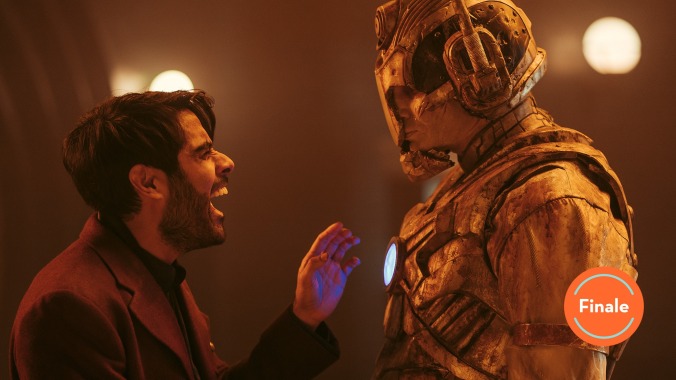Doctor Who’s season finale raises more questions than it answers


From the moment the Ninth Doctor first reached out to Rose Tyler, the image of taking someone’s hand has carried huge symbolic weight on Doctor Who. So it’s certainly no accident that “The Timeless Children” opens with the Master offering his hand to the Doctor (and then coercing her into actually taking it). For the first two-thirds of its runtime, “The Timeless Children” upends the usual Doctor Who format by positioning the Master as its protagonist and the Doctor as his wide-eyed, exposition-hungry companion. The dark, subtle subversion is an intriguing change of pace for a finale that promises to shift everything we know about the series. In the end, however, anchoring the story around the Master turns out to be a rather random stylistic choice in an episode chockfull of ideas but short on follow-through.
Once you peel back the tense cross-cutting, the plot itself is rather simple. The Master takes the Doctor to the ruins of Gallifrey, where he traps her in the Time Lord’s memory Matrix and uses a version of his consciousness to walk her through the story of the Timeless Child. Elsewhere, the real Master teams up with and then betrays Ashad as part of his plan to create a new race of regenerating Cyber Time Lords (with impeccable fashion sense, of course). And in the episode’s most pointless throughline, the companions and the human survivors team up to escape Ashad’s Cyber Warriors and then journey through the Boundary to help the Doctor—bringing a couple dues ex machinas with them.
Because the Master is (mostly) the protagonist of this episode and because he has the most fleshed-out emotional journey, his is the most interesting storyline to watch. Though it’s a shame to see Ashad wiped off the board halfway through the episode, it feels right that the Master would befriend him only to betray him. The Master’s plan to fuse with the Cyberium and form a new race of Cybermen in his own image is the perfect mix of clever, campy, and unsettling. And Sacha Dhawan’s performance remains appropriately fleet and fickle. The most telling moment is when the Master expresses genuine regret that Ashad’s destructive “death particle” didn’t active when he miniaturized him. This is a Master who has lost the will to live and is going through the universe-conquering motions largely because that’s what the Master is supposed to do. The performative quality of the Master’s villainy is just that—a performance. The episode’s most compelling moments are when the mask slips and the Master’s despondency comes through, allowing Dhawan to capture the heartbreak hidden beneath the camp.
The Master’s dark identity crisis stems from the discovery that his archenemy had a hand in shaping him—and in shaping all the Time Lords. It turns out the Doctor is the Timeless Child, a mysterious regenerating foundling whose DNA was spliced with that of the native Gallifreyan population in order to create the Time Lord race in the first place. Though the Master claims to be mad that the Time Lord’s “noble creation myth” is a lie, in truth, blowing up Gallifrey is more like a kid throwing a temper tantrum over a sibling rivalry. Not only does the Doctor get to be the chosen one and he doesn’t, the Master is essentially wearing her hand-me-down DNA.
Since Doctor Who has always presented the Time Lords as arrogant, elitist assholes, the reveal that they have some eugenics-flavored gene splicing in their past isn’t all that shocking. The big shift here is for the Doctor, who must grapple with the revelation that decades (if not centuries) of her early life have been erased from her memory—not to mention the fact that her actual origins are still a mystery. When all is said and done, however, we don’t learn too much here that we couldn’t have sussed out from Doctor Ruth’s appearance in “Fugitive Of The Judoon” or from the Brendan subplot in last week’s episode, which turns out to be a “visual filter” version of the Doctor’s true origin story. “The Timeless Children” fills in some gaps, but still leaves the biggest questions unanswered.
Where is the original Timeless Child Doctor from? How did she feel about being adopted and experimented on by her Gallifreyan explorer mother, Tecteun? What was it like to watch an entire race evolve because of her DNA? Was she a willing or unwilling recruit for the mysterious Gallifreyan spy organization “The Division”—the group we previously saw Doctor Ruth running from? And just how many regenerations occurred during the “redacted” portions of her memories? Because so much of the Doctor’s story this week is about the abstract absence of knowledge (and because she’s such a passive character throughout this episode), it’s hard to connect to her on a emotional level. In the end, the Doctor gets an exposition-heavy pep talk from a mental projection of Doctor Ruth, decides that the mysteries of her past don’t define who she is in the present, and then breaks out of the Matrix with the magical power of montage.
That’s where the episode really starts to fall apart. The resolution of “The Timeless Children” doesn’t feel earned on either a character level or a plot one. Though Ashad’s “death particle” was technically hinted at last week, it still mostly feels like it comes out of nowhere here. That’s also true of the last-minute reveal that Ko Sharmus was part of the group that sent the Cyberium back in time and therefore feels responsible for the Master having control of it now. Most egregiously, this episode undercuts the big heroic moment where the Doctor decides not to lower herself to the Master’s level of violence by having her happily accept that same amount of carnage so long as Ko Sharmus is the one pulling the trigger. Doctor Who has never been super consistent about the Doctor’s willingness to resort to violence, but the morality whiplash here is pretty unforgivable.
Like a lot of episodes this season, “The Timeless Children” is engaging to watch in the moment (especially when Dhawan is onscreen), but falls apart the longer you think about it. I’ve consistently praised the “anything can happen” quality of season 12, and this episode certainly has that in spades. I just wish it functioned better as a thematic capper to the season or even just an episodic story in its own right. Emotional beats like Ravio, Yedlarmi, and Ethan finally finding sanctuary after a life of endless warfare are strangely underplayed. And while Graham telling Yaz she’s impressive, and Ryan making the shot he missed in the season premiere are both sweet moments, none of the companions have had particularly compelling season-long storylines.
A lot of my reviews for this season have ended with variations on “we’ll just have to wait and see how these potentially intriguing ideas play out,” and I’m afraid I have to fall back on that sentiment once again. Ultimately, “The Timeless Children” raises far more questions than answers—right down to a cliffhanger ending that sees the Judoon teleport the Doctor to a maximum security asteroid prison. The post-credits tease promises the Doctor will return in “Revolution Of The Daleks,” which is set to air on either Christmas or New Year’s Day. We’ll have to wait until then (or maybe longer!) to see if giving the Doctor a mysterious backstory opens up fascinating new storytelling possibilities or just serves as a pointless retcon.
Stray observations
- If Tecteun’s “visual filter” was designed to make the Doctor’s memories seem unremarkable to anyone who stumbled upon them in the Matrix, why would they take place in Ireland and not Gallifrey?
- I enjoyed the Master’s disappointment that Ashad’s plan was just to turn the Cybermen into full-on robots.
- The Master’s frustration at thinking of a quippy one-liner moments too late was also great.
- Why did the Timeless Child Doctor regenerate so many times during her travels with Tecteun? Was that a natural part of her adolescence or were Tecteun’s experiments repeatedly killing her?
- I’m sure the Master will somehow survive the death particle bomb (we hear him yell at the Cyberlords to follow him as it detonates), but is this the official end of Gallifrey? Seems hard to come back from a double destruction.
- My guess is that “Revolution Of The Daleks” will pick up months or even years in the future, with the companions settled back into a human life (maybe Graham and Ravio are dating?) only for the Doctor to break out of jail and suddenly reappear in their lives.
- Thanks so much for following along with these reviews! I’m still sorting through how I feel about the season as a whole, which I found fairly exhilarating up through “Fugitive Of The Judoon” and then somewhat frustrating after. Hopefully I’ll have more cohesive thoughts by the time the holiday special rolls around. In the meantime, you can always chat with me about all things Who over on Twitter!